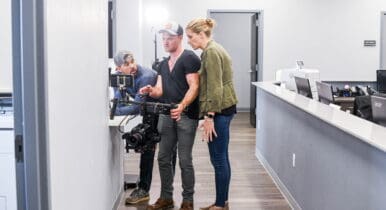Once In-Person Work Resumes, Will We See a New DC Dress Code?
When work life returns to the office, many political professionals will have a hard decision to make. Don their pre-pandemic wardrobe, which many of us are reevaluating for a myriad of reasons, keep the dress shirt-sweatpants combos they’ve sported on Zoom during work from home (WFH), or chart a new course? What will the new DC dress code look like?

When work life returns to the office, many political professionals will have a hard decision to make. Don their pre-pandemic wardrobe, which many of us are reevaluating for a myriad of reasons, keep the dress shirt-sweatpants combos they’ve sported on Zoom during work from home (WFH), or chart a new course?
Whether you’re a consultant, staffer or a future candidate, one thing is certain: it’s not as simple as it sounds. Even designers are having trouble weighing how much WFH to incorporate into their fall 2021 collections. That’s partly because we don’t know where society will be at with the pandemic in the coming months, and the rules between work and play attire continue to blur.
When the pandemic does end, I expect those connected directly to Capitol Hill to go back into full-on suit-and-tie mode. Given the changing nature of WFH, various professions around the Beltway may change permanently and, in turn, their wardrobe expectations as well. One thing is for sure though, those who dress well, stand out, and get remembered.
In recent years, the suit and other formal clothing has taken a back seat as companies focused on being hip and more egalitarian to attract millennials. While political correctness says it doesn’t matter what we wear or that we shouldn’t judge external appearances, the evidence over the past few thousand years says otherwise. Your clothes speak without you saying anything at all — this is particularly true in DC.
One reason why we fret over what we wear is that our clothes can mentally set the stage for the day ahead. There’s immense power in the placebo effect: When you feel well because of how you look, you can do well. Now, one should seek to be prepared for various situations that may arise throughout the day. This brings me to note the importance of building a transitional wardrobe. Such a closet includes individual pieces that fit into more than just one category — say from streetwear to casual, casual to cocktail or cocktail to formal. This allows one to prepare themselves for various events throughout the day and pivot to the needs of the hour.
The first benefit to owning transitional pieces is that they allow us to own less clothing and save money because functional pieces mix and match easily. Some brands, particularly, trend-setting high fashion companies, prefer to sell complete outfits. They maintain margins by only putting one item of the ensemble on sale at a time. Outfits also limit you to wearing this “one thing” throughout the day.
The seasons of fall and winter make it easier to buy transitional pieces as colder weather leads to layering with knits and wool. Let’s also not forget all of the post-holiday sales. For people in year-round warm climates, laying is still possible through recent innovation in the textile manufacturing industry which created thinner, more breathable man-made materials.
The sweater is a great unisex item with many variations such as the cardigan, v-neck, crew-neck, vest and shawl-collar just to name a few. All add an element of formality over a collared shirt. Instead of a traditional navy blazer like the one Brooks Brothers has sold for over 100 years, select one with a hopsack weave pattern in a dark blue.
It will serve as the ultimate piece to have on standby. Its unisex works with all body shapes, sizes, and skin color. Best of all, this blue will match nearly everything in your closet. It’s generally made with an unconstructed shoulder which makes it more comfortable than a suit jacket, will layer easier and can be dressed up in a moment’s notice with a tie or ascot.
Nobody knows for sure when the pandemic will end or if people will ever be pulled back into the office with their rotation of suits, blouses, slacks, and the like. Regardless, this is a great time to experiment with clothing you might not have previously considered and get feedback from family and friends. The retail industry has been hit hard this year so the sales are hot right now. But remember: some sale items are unreturnable, so weigh your wardrobe investment accordingly so you don’t get a buyer’s remorse hangover.
Robert Ordway is a Congressional Staffer and a certified clothier of the Custom Tailors and Designers Association (CTDA).

